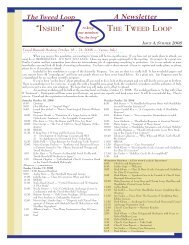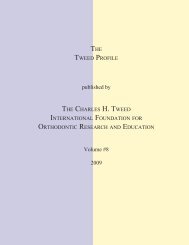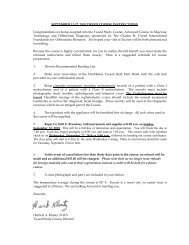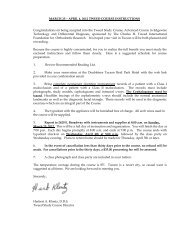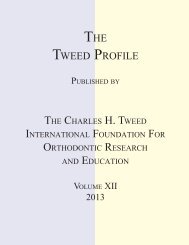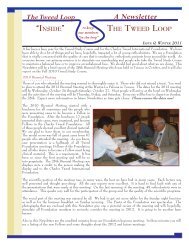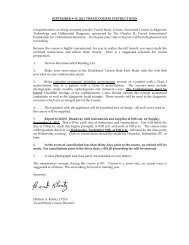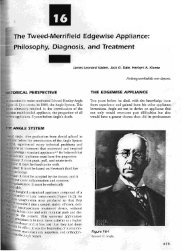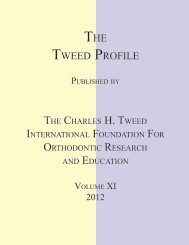© 2006 - The Charles H. Tweed International Foundation
© 2006 - The Charles H. Tweed International Foundation
© 2006 - The Charles H. Tweed International Foundation
You also want an ePaper? Increase the reach of your titles
YUMPU automatically turns print PDFs into web optimized ePapers that Google loves.
<strong>The</strong> Extraction/Nonextraction Dilemma – <strong>The</strong> Class II SolutionHerb Klontz<strong>The</strong> extraction/nonextraction problem is essentially a 4-7 mm dilemma. If crowding, cephalometric correction,curve of Spee correction or a combination of these things is greater than 7 mm, the patient generally needs extractions.Nonextraction treatment will procline the teeth if space is not available. <strong>The</strong> clinician’s job is to consider all of thediagnostic information and make a decision that is in the best interest of the patient. This decision must consideresthetics, health and function, stability and treatment in harmony with growth. <strong>The</strong> diagnosis which leads the clinicianto a treatment plan must be based upon the facial esthetics of the patient prior to treatment, the skeletal pattern(whether or not the patient has a high or a low mandibular plane angle), the tooth arch discrepancy or excess, and theanteroposterior discrepancy.Facial EstheticsWhen the clinician considers facial esthetics, the desire is either to maintain a very nice face or to improve aface. If the face is to be maintained, the clinician has to determine whether or not there is space in the arches for all ofthe teeth, how much curve of Spee is present, and whether or not the curve of Spee can be leveled without flaring lowerincisors. Flaring lower incisors on a face that is pleasing at the outset of treatment will ruin the face. An anteroposteriordiscrepancy, if it exists, has to be addressed in the posterior part of the mouth.If the face is out of balance due to protrusion, the protrusion must be addressed. <strong>The</strong>se patients generally needextractions so that the teeth can be moved back over basal bone in order to improve facial esthetics.Skeletal PatternHigh Angle – For the patient who has a high angle skeletal pattern, mandibular incisor uprighting is essential.Whether or not the patient has crowding is irrelevant. <strong>The</strong> cephalometric correction must be utilized and respected.Most of these patients must have extractions. If these patients are treated without extraction, the lower lip will beprotruded and facial esthetics will be unacceptable. <strong>The</strong>se patients are not borderline extraction patients. <strong>The</strong>y must beextracted if facial balance is to be improved.Low Angle – <strong>The</strong>se patients generally do not need incisor uprighting, but by the same token, mandibular incisorscannot be proclined. If incisors are proclined, facial balance is harmed and an unstable dentition is created. <strong>The</strong>sepatients generally have an anteroposterior problem as well as a vertical problem.Anteroposterior Discrepancy<strong>The</strong> anteroposterior problem must be resolved in the maxillary arch. One of three diagnostic scenarios is usedto correct anteroposterior problems. Either all the maxillary teeth must be distilized or the patient must be treated toa Class I canine, Class II molar relationship with only maxillary premolar extraction. In some patients the Class II istreated to a Class I canine, Class I molar relationship with extraction of maxillary and mandibular premolars.<strong>The</strong> Class II Solution<strong>The</strong> diagnosis of a patient with a Class II malocclusion or with any sort of an anteroposterior discrepancymust be done with the idea that it requires space to correct the dental relationship. <strong>The</strong> tooth arch discrepancy isconsidered, the curve of Spee is considered, and the antero-posterior discrepancy is considered. <strong>The</strong> anteroposteriordiscrepancy cannot be resolved in the mandibular arch because these patients generally have mandibular teeth thatare in their proper positions or that need very little adjustment. <strong>The</strong> Class II diagnostic decision for these patients istherefore based upon the face and the tooth arch discrepancy - which includes crowding, the curve of Spee correction- and the anteroposterior correction decision. For these patients, one has to distalize the maxillary posterior teeth orremove some teeth in the maxillary arch only or in both maxillary and mandibular arches. Treatment of non premolarextraction patients (Figure 1-9) (Molly Baxter) generally requires for the third molars to be extracted in order to gainspace in the posterior part of the mouth. If only maxillary teeth are removed, it is generally maxillary first premolars ormaxillary second premolars. <strong>The</strong>se patients also require that mandibular third molars be carefully evaluated and quitepossibly removed. Figures 10-17 (Ashley Adams) are illustrative of this type of patient.25




